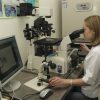
MOSCOW, January 18 Employees of Lomonosov Moscow State University have received new, cheap and non-toxic chemical compounds that effectively convert X-ray radiation into visible light; these materials, according to scientists, will help create more efficient X-ray machines and ionizing radiation sensors radiation, the Russian Science Foundation reported.
Materials that emit visible light when exposed to X-rays or other ionizing radiation are called scintillators. They are widely used in medicine and technology: in X-ray machines, security tapes at airports, as well as in devices for checking the quality of a wide variety of materials. Hybrid manganese halides—compounds of manganese halides with organic amine halides—are considered one of the most promising scintillators. They are good because they can absorb and emit light over a wide range of wavelengths, so the same substance can be used in many devices for different purposes. In addition, these materials are cheap to produce and non-toxic.
However, most hybrid manganese halides studied to date contain bulky organic molecules that reduce the material's density and therefore its ability to absorb and convert X-rays. Because of this, it is necessary to use thick layers of material, which increases the size of the devices and does not allow achieving high resolution.
Scientists from Moscow State University have synthesized four compounds of manganese with bromine and compact organic residues. A comparison with other currently existing hybrid manganese halides has shown that the new materials are much more efficient at converting high-energy radiation incident on them into visible light. For example, materials with bulky organic molecules exhibit complete absorption only if their thickness is several millimeters. In the case of new molecules, a submillimeter layer is sufficient for a similar result, which means they can be used in miniature ionizing radiation sensors and medical devices.
«
“Unlike most similar materials, the samples we synthesized have a relatively high density due to the fact that the organic components of the structure in them occupy a small fraction of the volume. This allows them to more effectively capture X-ray and visible radiation, and then convert it,” explained Sergei Fateev, a project participant, Candidate of Chemical Sciences, researcher at the Laboratory of New Materials for Solar Energy, Faculty of Materials Sciences, Moscow State University.
» «In the future, we plan to explore systems with other organic molecules and halogens to find materials that are most effective in creating thin-film optoelectronic devices for detecting ionizing radiation. In our work, we strive to develop effective prototypes of X-ray detectors and imaging screens used in medicine and scientific research,» — noted the project manager, candidate of chemical sciences, head of the same laboratory Alexey Tarasov.


























































Свежие комментарии